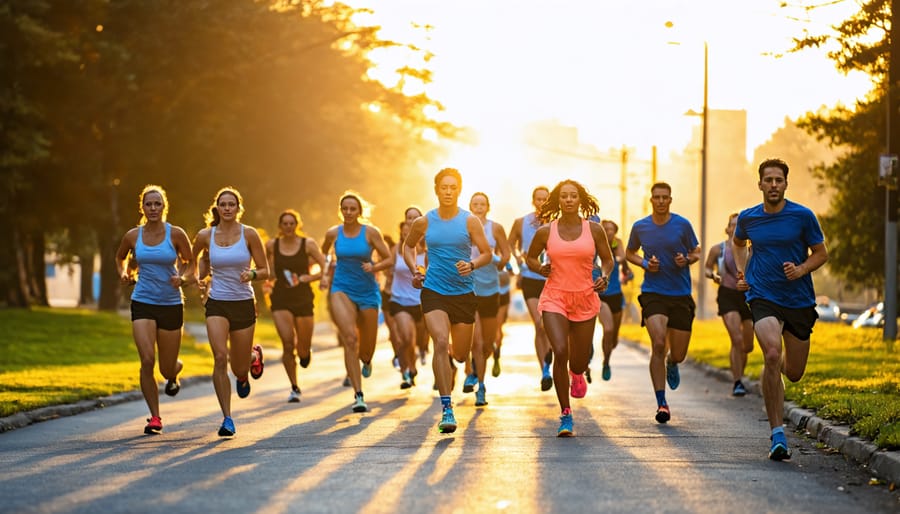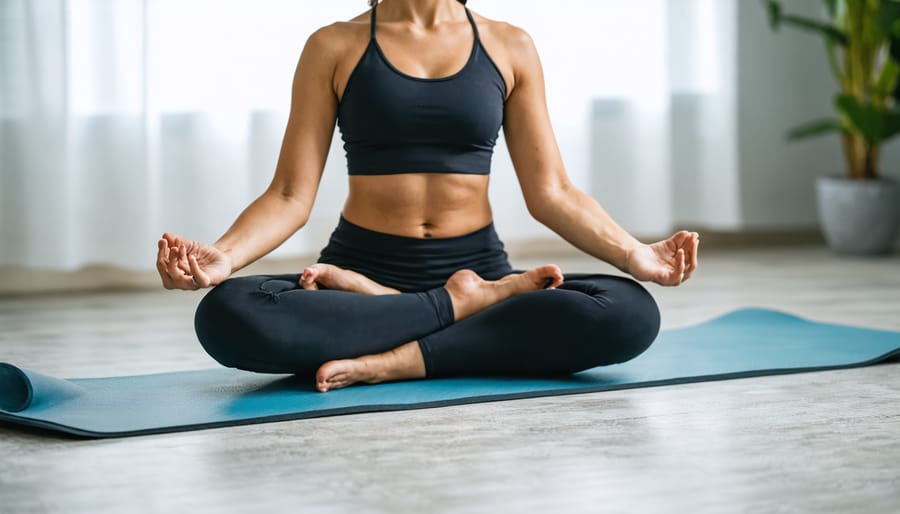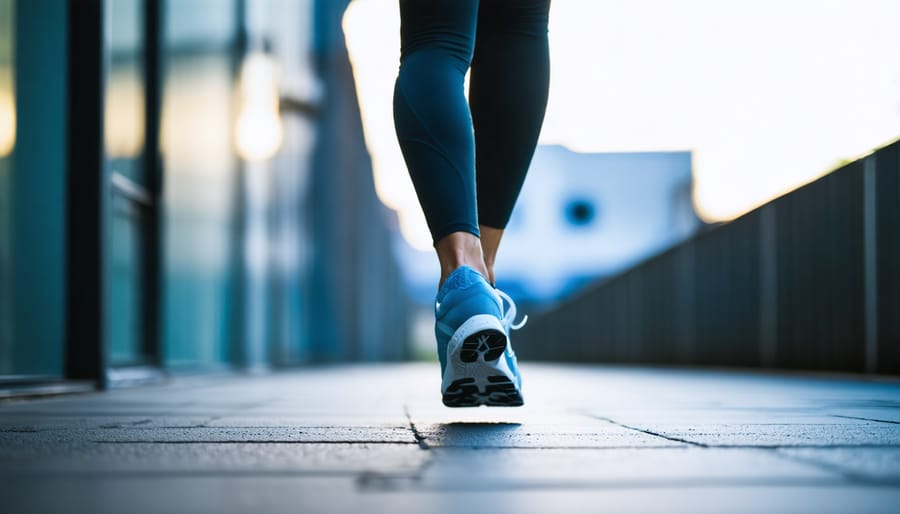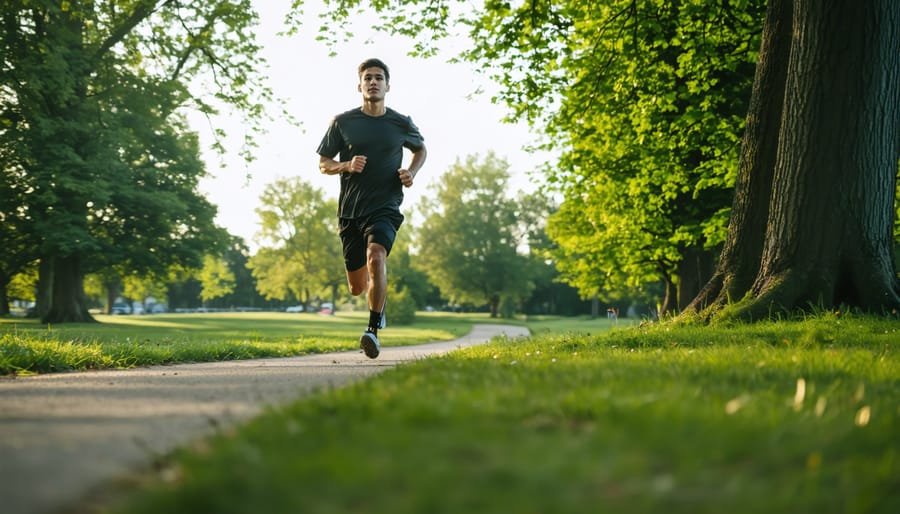When anxiety tightens its grip, your body holds a powerful solution: exercise. Research consistently shows that just 30 minutes of physical activity can reduce anxiety symptoms as effectively as some medications, triggering the release of mood-boosting endorphins and lowering stress hormones like cortisol. From a brisk walk in the park to an intense gym session, movement creates a natural “time-out” from worried thoughts while strengthening both body and mind.
The science is clear: regular exercise changes brain chemistry, increasing vital neurotransmitters like serotonin and GABA that help calm anxious minds. Studies from leading institutions, including Harvard Medical School, demonstrate that active people experience up to 60% fewer anxiety symptoms than sedentary individuals. Even better, these benefits can start within minutes of beginning your workout and last for hours afterward.
Whether you’re dealing with occasional stress or chronic anxiety, incorporating regular physical activity into your daily routine offers a natural, accessible way to find relief and build resilience.
How Exercise Fights Anxiety: The Science Behind the Relief
The Stress-Busting Brain Chemicals
When you exercise, your brain becomes a natural pharmacy, releasing powerful chemicals that help reduce anxiety. These “feel-good” neurotransmitters work together to create a sense of calm and well-being that can last for hours after your workout.
Endorphins, often called nature’s painkillers, are released during physical activity and create a mild euphoric effect, similar to a “runner’s high.” These chemicals help reduce stress and promote a positive mood while decreasing pain sensitivity.
Serotonin levels also increase during exercise, helping to regulate mood, sleep, and appetite. This important neurotransmitter is often called the “happiness chemical” because of its role in promoting feelings of contentment and reducing anxiety symptoms.
Exercise also boosts the production of GABA (gamma-aminobutyric acid), a calming neurotransmitter that helps quiet anxious thoughts. Additionally, physical activity reduces levels of stress hormones like cortisol and adrenaline, which can contribute to anxiety when elevated.
Regular exercise creates a compound effect, helping your brain become more efficient at producing and using these beneficial chemicals over time.
Physical Changes That Reduce Anxiety
Exercise triggers several beneficial physical changes that help reduce anxiety levels in your body. When you engage in physical activity, your brain releases endorphins and other natural mood-enhancing chemicals that act as natural stress relievers. These “feel-good” hormones help counter the effects of stress hormones like cortisol and adrenaline.
Regular physical activity also helps reduce muscle tension, a common physical symptom of anxiety. As you exercise, your muscles contract and relax, releasing built-up tension that often accumulates in areas like your shoulders, neck, and back. This physical release can help break the anxiety-tension cycle that many people experience.
Additionally, exercise helps regulate your body’s stress response system. Over time, regular physical activity can lower your resting heart rate and blood pressure, making your body more resilient to stress triggers. It also improves sleep quality, which is essential for managing anxiety levels, as poor sleep often intensifies anxiety symptoms.
The physical benefits of exercise create a ripple effect, helping you feel more in control of your body and better equipped to handle stress and anxiety.
Best Anxiety-Reducing Exercises
Aerobic Activities
Aerobic activities, also known as cardio exercises, are particularly effective at reducing anxiety symptoms. These exercises increase heart rate and breathing, triggering the release of endorphins – natural mood lifters that help combat stress and anxiety. Common aerobic activities include brisk walking, jogging, swimming, cycling, and dancing.
Walking is an excellent starting point for those new to exercise or dealing with anxiety. It’s low-impact, requires no special equipment, and can be done almost anywhere. Just 30 minutes of brisk walking five times a week can significantly improve anxiety symptoms.
Swimming offers a unique combination of rhythmic breathing and full-body movement, which can be especially calming for those experiencing anxiety. The water’s buoyancy also reduces joint stress, making it ideal for people of all fitness levels.
Cycling, whether outdoors or on a stationary bike, provides a great cardiovascular workout while being gentle on the joints. Many people find the repetitive motion meditative, helping to clear their minds and reduce anxious thoughts.
Remember to start slowly and gradually increase intensity as your fitness improves. The goal is to aim for at least 150 minutes of moderate-intensity aerobic activity each week.

Mindful Movement
Integrating movement with mindfulness can be particularly effective for anxiety reduction. Mindfulness-based exercises like yoga and tai chi combine gentle physical activity with mental focus, creating a powerful tool for stress management.
Yoga practice encourages deep breathing while moving through poses, helping to activate your body’s relaxation response. Whether you’re new to yoga or experienced, the combination of controlled movements and breath awareness can help quiet anxious thoughts and reduce muscle tension.
Tai chi, often described as “meditation in motion,” offers similar benefits through its flowing movements and emphasis on present-moment awareness. This ancient practice can help improve balance and flexibility while reducing stress and anxiety levels.
Other mindful movement practices include gentle stretching, walking meditation, and qigong. These activities allow you to focus on the connection between your body and mind, creating a sense of calm and groundedness. Even dedicating 10-15 minutes daily to these practices can make a noticeable difference in managing anxiety symptoms.

Strength Training
Strength training offers powerful anxiety-reducing benefits through both physical and psychological mechanisms. When you engage in resistance exercises, your body releases endorphins and other mood-enhancing chemicals that help combat stress and anxiety. Regular strength training also builds physical confidence and increases your sense of capability, which can help reduce anxiety-related feelings of helplessness.
Start with bodyweight exercises like push-ups, squats, and lunges if you’re new to strength training. As you become more comfortable, gradually incorporate light weights or resistance bands. Aim for 2-3 strength training sessions per week, focusing on major muscle groups. Remember to maintain proper form and breathe steadily throughout your exercises.
Research shows that even a single session of strength training can help reduce anxiety symptoms, while consistent practice over time leads to more lasting benefits. The key is to start gradually and listen to your body, allowing yourself to build strength and confidence at your own pace.
Creating Your Anxiety-Management Exercise Routine

Getting Started Safely
Before starting any exercise program, it’s essential to approach it safely and gradually, especially if you’re dealing with anxiety. Begin by consulting your healthcare provider to ensure exercise is safe for your specific situation. They can help identify any potential risks and provide personalized recommendations.
Start with gentle activities that feel manageable and comfortable. Walking, swimming, or basic stretching are excellent low-impact options for beginners. If you’re nervous about exercising in public spaces, consider starting at home or in quiet outdoor areas. Many people find it helpful to learn how to overcome gym anxiety gradually with support from friends or fitness professionals.
Set realistic goals and progress at your own pace. Begin with short sessions of 10-15 minutes and gradually increase duration as your comfort and confidence grow. Listen to your body and respect its limits. It’s perfectly fine to take breaks when needed.
Remember to:
– Warm up properly before exercise
– Stay hydrated throughout your workout
– Wear comfortable, appropriate clothing
– Choose activities you enjoy
– Track your progress in a way that feels supportive rather than pressuring
Starting slowly helps build sustainable habits while minimizing the risk of injury or overwhelming yourself.
Making It Stick
Developing a consistent exercise routine takes time and patience, especially when managing anxiety. Start by setting realistic goals that feel achievable – even if it’s just a 10-minute walk each day. Schedule your workouts at the same time daily to create a sustainable habit, and treat these appointments with yourself as non-negotiable commitments.
Track your progress using a fitness app or journal, noting not just your physical activity but also how you feel before and after exercising. This can help reinforce the anxiety-reducing benefits and keep you motivated. Consider finding an exercise buddy who can provide accountability and support, making the experience more enjoyable and social.
If you miss a day, be gentle with yourself and simply resume the next day. Remember that consistency matters more than perfection. Keep your exercise gear visible and easily accessible – lay out your workout clothes the night before or keep your walking shoes by the door.
Celebrate small wins along the way, whether it’s completing a full week of planned activities or noticing improvements in your anxiety levels. Consider joining local fitness groups or online communities where you can share experiences and find additional motivation from others on similar journeys.
When to Combine Exercise with Other Anxiety Treatments
Exercise can be a powerful tool in managing anxiety, but it works best when integrated with other treatment approaches. While physical activity helps build stress resilience, combining it with other strategies creates a more comprehensive approach to anxiety management.
Consider incorporating exercise alongside professional therapy, particularly cognitive-behavioral therapy (CBT). This combination can be especially effective as the physical benefits of exercise complement the mental strategies learned in therapy sessions. Many mental health professionals actively encourage their clients to maintain regular physical activity as part of their treatment plan.
If you’re taking anti-anxiety medications, exercise can work safely alongside these treatments. However, always consult your healthcare provider before starting a new exercise routine. They can help you determine the right balance between physical activity and other treatments based on your specific situation.
Other complementary approaches include meditation, deep breathing exercises, and mindfulness practices. These can be particularly effective when combined with gentle forms of exercise like yoga or tai chi. Creating a routine that includes both movement and relaxation techniques often yields better results than relying on exercise alone.
Remember that everyone’s anxiety management needs are different, and it may take time to find the right combination of treatments that works for you. Start gradually and adjust your approach based on what feels most beneficial for your mental health.
Exercise has proven to be a powerful tool in managing anxiety, offering both immediate relief and long-term benefits. By incorporating regular physical activity into your daily routine, you can reduce stress hormones, boost mood-enhancing chemicals, and build resilience against anxiety symptoms. Whether you choose walking, swimming, yoga, or strength training, the key is to start slowly and maintain consistency. Remember that even small amounts of exercise can make a significant difference in how you feel. Make a commitment today to take that first step toward better mental health through exercise. You don’t need to transform your entire lifestyle overnight – begin with short, manageable sessions and gradually increase your activity level as you feel more comfortable. Your future self will thank you for making this positive change in your anxiety management strategy.

